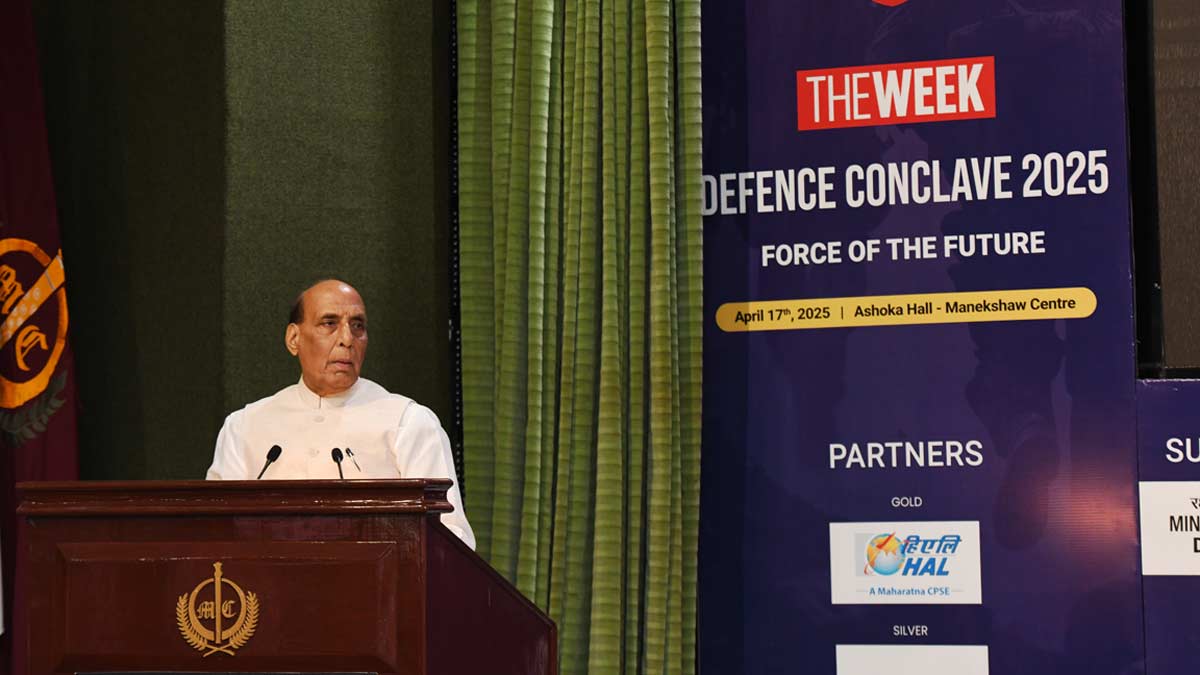THE WEEK Defence Conclave 2025: ‘Today, when India speaks, the world listens’, says Rajnath Singh
 Defence Minister Rajnath Singh addresses the audience at ‘THE WEEK Defence Conclave 2025: Force of the Future’ in New Delhi | Sanjay Ahlawat
Defence Minister Rajnath Singh addresses the audience at ‘THE WEEK Defence Conclave 2025: Force of the Future’ in New Delhi | Sanjay Ahlawat
As the nature of warfare becomes more unpredictable and asymmetric, India is rapidly adapting to meet the emerging challenges of modern conflict, Defence Minister Rajnath Singh said on Thursday. Speaking at THE WEEK Defence Conclave 2025: Force of the Future in New Delhi, Singh warned of rising threats from non-state actors, cyber warfare, and space-based systems, stating that the global security landscape is undergoing a profound transformation.
“Conflicts in the future will be more violent, unconventional, and technology-driven. Non-state actors will play a larger role, and domains like cyber and space will define new battlefields,” Singh said. “We are preparing our armed forces through structural reforms and continuous capacity-building. Our goal is not to initiate war, but to maintain a credible deterrence for lasting peace.” The defence minister said since Prime Minister Narendra Modi government came to power, India defence capabilities have vastly improved as the government brought mindset change. “India is now taken seriously at the global stage, unlike earlier.”
Singh inaugurated the day-long defence conclave at the Manekshaw Centre in the national capital. Speaking at the well-attended conclave, which witnessed participation of senior defence officers, technocrats, scientists, innovators, he highlighted the transformational journey of India’s defence sector under the Modi government since 2014. He said it has been a sharp shift from dependency on imports to self-reliance. “The earlier mindset was to import whatever we needed. We changed that. We now trust Indian potential and capabilities.”
A cornerstone of this shift is the ‘Positive Indigenisation List’, which currently features 509 defence items to be produced domestically. Additionally, over 5,000 critical replacement parts will now be manufactured in India through Defence Public Sector Undertakings (DPSUs).
He also pointed to budgetary reforms, including the reservation of 75 per cent of the defence capital procurement budget for domestic companies. “This is a big step to promote our local industries,” Singh said.
The defence minister said defence exports have witnessed a dramatic rise—from Rs 686 crore in 2013–14 to approximately Rs 24,000 crore in 2024. “Today, around 100 countries are sourcing defence equipment from us. We aim to cross Rs 30,000 crore by the end of this year and reach Rs 50,000 crore by 2029,” Singh said.
Initiatives like the Technology Development Fund (TDF) and Innovations for Defence Excellence (iDEX) have helped India support homegrown startups and MSMEs in developing cutting-edge military technologies. Singh also spoke about the ADITI scheme, which provides startups with up to Rs 25 crore to innovate in defence.
Singh described the restructuring of India’s 200-year-old ordnance factories as “one of the biggest reforms of this century.” These units, now modernised and efficient, have become profit-making entities without any disruption from labour unrest.
He also mentioned major reforms such as the appointment of a Chief of Defence Staff and progress toward integrated theatre commands. “Our soldiers on the borders are now equipped with modern weapons. Women’s participation in the armed forces has also increased, strengthening our overall defence structure,” he noted.
As the theme of the conclave was ‘Force of the Future’, defence minister highlighted the progress made in building national defence capabilities.
“Make in India” is no longer just a national strategy—it is now aimed at fulfilling global defence needs, Singh said. The Indian Navy and Coast Guard, with over 79 per cent of their ships are made in India, have already begun exporting to friendly nations.
“In today’s uncertain geopolitical environment, we are shifting from a ‘just in time’ to a ‘just in case’ approach—building inventory, creating backups, and preparing for all scenarios,” he explained.
However, the minister also expressed his concern over the delay in development of aero engine. “There could be some delay, but I am confident that we will achieve the target of manufacturing it in India at the earliest.” On Kaveri engine, he said India has made huge progress.
Calling 2025 the “Year of Reforms” in defence, Singh concluded, “India’s defence sector is not only growing stronger domestically but also gaining recognition globally. Earlier, India wasn’t taken seriously. But today, when India speaks, the world listens. Our aim is clear—to become a developed nation and a leading military power.”
THE WEEK conclave’s theme reflected the tectonic shifts underway in India’s defence narrative - driven by technological advancements, geopolitical challenges, and the push for ‘Atmanirbharta’ (self-reliance). Across seven panel discussions, participants explored everything from defence reforms and indigenous production to emerging technologies and the evolving role of startups and MSMEs in the sector.
Rajnath Singh launches THE WEEK’s microsite for defence coverage
Singh, along with Riyad Mathew, Chief Associate Editor, THE WEEK and Director of the Malayala Manorama group, also launched a dedicated microsite for defence news on THE WEEK’s website. Congratulating THE WEEK for its continuous coverage of defence matters and organising its first defence conclave, Singh said the publication with its loyal readership will surely leave its mark in the digital space as well.
Speaking at the inauguration of the conclave, Riyad Mathew highlighted THE WEEK’s commitment on covering the defence stories from conflict zones to new technological advancements. He reiterated THE WEEK’s commitment to the defence coverage, listing out the important covers done over the years, and now the launch of new microsite would further enhance publication reach in the online space. He assured that the key initiatives of the government and the armed forces will be regularly highlighted.
Defence